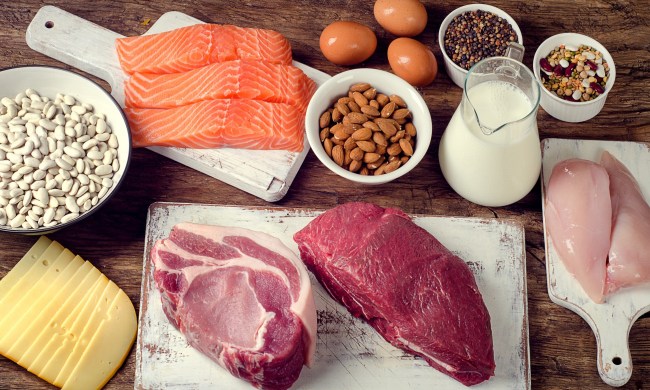‘Tis the season for festive gatherings, illuminated trees, and of course, indulgent holiday libations. But what if there was a way you could turn those rich adult beverages into low-calorie cocktails? Whether you’re watching your waistline or simply aiming for a healthier approach to holiday cheer, join us on a journey of crafting low-calorie versions of your cherished Christmas cocktails.

How to make classic Christmas cocktails with fewer calories
It’s easier than you may think to turn your favorite festive cocktails into lower-calorie delights. Here are a few of our best-kept secrets when it comes to creating delicious cocktails without the guilt. Experiment with different mixers and ingredients to find what works best for you. And don’t forget to enjoy responsibly!
- Swap out sugary sodas or juices for waistline-friendly mixers like club soda, seltzer water, or diet soda.
- Choose lighter alcoholic options, such as low-calorie spirits or light beer, to trim down the calorie count.
- Add fresh fruit, herbs, and spices to your concoctions for flavor without the calories.
- You can significantly reduce your calorie intake by drinking in moderation and alternating between alcoholic and nonalcoholic beverages throughout the night.
With these simple tweaks, you can savor your cherished cocktails guilt-free, reveling in both taste and well-being. Let’s take a closer look at some of this season’s most popular holiday cocktails.

Eggnog
Eggnog has been a holiday favorite for centuries. As one of the highest calorie-dense drinks you can have, Eggnog is typically made with heavy cream, eggs, sugar, and your favorite spirit. A great option to lower the fat content is to swap the cream for light coconut milk. Not only is this plant-based option going to appeal to those with dairy allergies, but it also lends itself well to tropical riffs on your decadent holiday favorite. Add aged rums and spices to your coconut egg nog, and you’ll be transported to a tropical holiday paradise.
If lowering carbs and sugars is more of a priority, swapping out traditional sweeteners like sugar is also an easy way to lower the caloric content. Agave is a natural sweetener that has a lower glycemic index and has the benefit of being 1.3 times sweeter than sugar. This allows you to use less, not change the flavor. For even fewer calories, add natural sweeteners like monk fruit or stevia.

Moscow mule
A Moscow mule is a great drink to enjoy during the holidays. The Moscow Mule is believed to have originated in the early 1940s. This drink is usually served in a copper mug and is a combination of vodka, ginger beer, and lime. During the 1980s, this cocktail sparked the vodka revolution, ultimately reshaping cocktail culture.
Ginger beer, however, usually contains more sugar than soda. The good news is that you can easily make ginger beer at home. Using a blender or juicer, juice or blend fresh ginger. Add a splash of water if need be or strain to remove any fiber. Once you have ginger juice, mix it with soda water. To go one step further, add your favorite sugar-free syrup to taste for some spicy homemade ginger beer.

Sangria
Ready-to-drink bottled sangria is known for packing a lot of added sugar. However, it is easy to make a great sangria at home without the extra calories. Start by adding fresh fruit like oranges, apples, and pomegranate to your favorite dry wine. Then, you can add your favorite holiday spices like cinnamon, allspice, and clove.
For a sweeter taste, you might want to add some stevia or monk fruit to the recipe. Additionally, if you want your holiday guests to have a little extra fun, you can add brandy or whisky to a red sangria. Be careful; the more alcohol you consume, the more calories you’ll take in. For white sangria, add gin or vodka.

White Russian
Similar to eggnog, the White Russian, a creamy cocktail ideal for colder seasons, blends Kahlua, vodka, and cream. Presented in a rocks glass, enhance the festive vibe by topping it with a dusting of cocoa powder or a cinnamon stick for an extra layer of flavor. To trim calories, swap regular cream for almond milk or coconut water.
For a healthier twist, consider replacing Kahlua with coffee to reduce sugar intake and lower the overall alcohol content, thus lowering the number of calories consumed. These modifications not only cater to taste preferences but also offer a lighter alternative to the classic White Russian.
In the spirit of festive celebrations, transforming indulgent holiday cocktails into guilt-free delights is a rewarding endeavor. From the rich history of eggnog, a centuries-old favorite, to the Moscow Mule’s role in sparking the vodka revolution, each cocktail holds a unique place in the tradition of Christmas libations.
By adopting clever strategies, such as using light coconut milk for eggnog, crafting homemade ginger beer with sugar-free sweeteners for Moscow Mules, and sweetening sangria with stevia or monk fruit, revelers can enjoy the season’s beloved drinks with fewer calories. Embracing these creative adjustments ensures that the holiday cheer can be both delectable and health-conscious.




